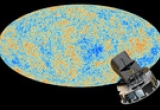The Planck satellite has completed its mission
After 1,554 days in space, the Planck satellite has completed its observations on 14 August 14th, 2013. If the high frequency instrument HFI stopped operating on January 14th, 2012, the low frequency instrument LFI was able to work around an additional 600 days as its operating temperature is much higher than HFI. There remains to "park" the satellite in the solar system before saying goodbye.
Planck was carrying two instruments, LFI and HFI, which observed the sky in the radio for the first and in the far infrared and submillimetre range for the second. Planck gave his first cosmological results in April 2013 with the finest picture ever obtained of the cosmic microwave background. HFI was carried out under the project supervision of the IAS in Orsay, and many other French laboratories are involved in Planck, thanks to the CNES, CNRS, and universities.
The detectors of HFI can only function at the extreme temperature of -273.05 °C, only 0.1 degrees above absolute zero. The refrigeration system to achieve this extreme temperature consumes very specific gas whose reserves have been exhausted board in early 2012 and HFI was stopped after a successful mission and an operation duration much higher than requirements. Stopped, not completely, as the second cryogenic stage (at 4K) was continuing to maintain the reference temperature of the HFI horns, as well as the 20K stage which was continuing to allow the LFI radiometers to operate in optimal conditions. The low frequency instrument LFI was then able to continue its observations.
Eight sky coverages for LFI
The best compromise between scientific objectives and operating costs was to extend the mission until 14 August 2013 to allow LFI to make eight complete maps of the sky (instead of almost five for HFI).
These eight independent maps allow multiple combinations: Researchers can then firstly reduce the measurement noise, and also very finely control the instrumental response. Thus, the quality of the maps at 30, 50 and 70 GHz of the entire mission will be much higher than the nominal mission consisting in only two full coverages of the sky.
The end of LFI means the end of Planck
Astrophysicists now have all the data at their disposal, the observational part of the mission is completed. A few months of work are remaining for ESA engineers. In fact, the satellite is on a pseudo-stable orbit around an unstable equilibrium point - the L2 Lagrange point of the Sun-Earth system, and it cannot remain there without regular maneuvering. It is also prudent to leave room for future satellites. It should therefore be led to its "retired satellite" orbit.
Long months of scientific analysis
The end of satellite observations does not mean the end of the scientific analysis. After publishing thirty scientific articles in April 2013 with the first 15 months of data, the Planck consortium is working on the next batch of cosmological results in mid-2014, based on the 29-month of joint operation between HFI and LFI.
Links:
CNRS/INSU news
Planck web site at ESA
Planck science papers
Planck products (images, catalogues, etc..)
[[{"type":"media","view_mode":"media_original","fid":"91","attributes":{"alt":"","class":"media-image","height":"434","style":"width: 700px; height: 434px;","typeof":"foaf:Image","width":"700"}}]]
Vue d'artiste du satellite Planck et image du fond cosmologique mesuré. Crédits: ESA and the Planck Collaboration - D. Ducros




